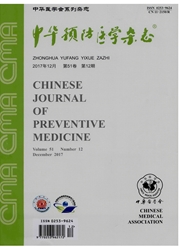

 中文摘要:
中文摘要:
目的:调查中国玉米饲料原料中真菌及其毒素的污染状况。方法2014年2月份分别从安徽、河北、黑龙江、吉林、江苏、辽宁、内蒙古和山东8个省份采集玉米饲料原料样品,共计94份。采用高效液相色谱-串联质谱法同时检测样品中黄曲霉毒素(AF)、A类和B类单端孢霉烯族化合物、玉米赤霉烯酮(ZEN)共12种真菌毒素的含量;并对样品中的污染真菌进行鉴定和计数。结果36.2%(34/94)的样品受到不同程度的AF污染,以AFB1含量最高,含量范围为0.3~181.3μg/kg;其次为AFB2,含量范围为1.0~74.3μg/kg;7份样品(7.5%,7/94)AFB1含量超过我国规定的限量标准(50μg/kg)。A类单端孢霉烯族化合物的污染水平均较低,含量范围为0.1~10.5μg/kg。B类单端孢霉烯族化合物以脱氧雪腐镰刀菌烯醇(DON)的污染最为严重,检出率为100%,含量范围为0.7~606.6μg/kg,中位数为66.3μg/kg,但所有样品中DON的含量均低于我国规定的限量标准(1000μg/kg)。76.6%(72/94)的样品检出ZEN,中位数为36.9μg/kg;3份样品(3.2%,3/94)ZEN含量超过我国规定的限量标准(500μg/kg)。真菌污染调查表明,所有样品均受到不同程度的真菌污染(5.0~1.4×105 CFU/g),分别有18份和3份样品的带菌量超过限用标准和禁用标准。曲霉属、青霉属、镰刀菌属、木霉属和毛霉属是主要的污染真菌,其检出率分别为71.3%(67份)、60.6%(57份)、71.3%(67份)、27.7%(26份)和24.5%(23份)。串珠镰刀菌的检出率[73.4%(69/94)]高于黄曲霉的检出率[41.5%(39/94)]。结论本实验发现玉米原料受AF和A类单端孢霉烯族化合物污染的水平较低,主要受到B类单端孢霉烯族化合物DON及其衍生物和ZEN的污染;同时还受到曲霉属、青霉属、镰刀菌等多种真菌的污染。
 英文摘要:
英文摘要:
Objective To investigate fungi contamination and the natural occurrence of mycotoxins in corn feed ingredients collected from China. Methods A total of 94 corn feed ingredient samples were collected from 8 Chinese provinces (i.e., Anhui, Hebei, Heilongjiang, Jilin, Jiangsu, Liaoning, Inner Mongolia, and Shandong) in February 2014. A tandem ultra-performance liquid chromatography-mass spectrometry method was used for simultaneous detection of twelve kinds of mycotoxins, including aflatoxin (AF), type A and type B tricothecenes, and zearalenone (ZEN). Contaminated fungi were also identified and counted. Results AF was detected in 36.2%(34/94) of samples;the concentration of AFB1 was the highest in the four AFs with the range:0.3~181.3μg/kg;and then followed by AFB2 (range:1.0-74.3μg/kg). There were 7 samples (7.5%) with AFB1 concentrations higher than the tolerance limit of 50 μg/kg. The concentration of type A tricothecenes in all samples was lower (0.1-10.5μg/kg). DON had the most serious contamination than other kind of type B tricothecenes (range: 0.7-606.6 μg/kg; median: 66.3 μg/kg). The DON concentration in all samples was below the tolerance limit of 1 000μg/kg. ZEN was detected in 76.6%(72/94) of samples (median: 36.9 μg/kg), with 3 samples having ZEN concentrations higher than the tolerance limit of 500μg/kg. The survey on fungi contamination showed that all samples were contaminated by fungi (range:5.0-1.4×105 CFU/g). There were 18 and 3 samples with quantities of fungi higher than the tolerance and forbidden limits, respectively. The Aspergillus, Penicillium, Fusarium, Trichoderma and Mucor genuses were the predominant fungi in corn feed ingredients, with detection rates of 71.3%(67), 60.6%(57), 71.3%(67), 27.7%(26), and 24.5%(23), respectively. The detection rate of Fusarium moniliforme, 73.4%(69/94) was higher than that of Aspergillus flavus, 41.5% (39/94). Conclusion In this survey, the corn feed ingredients
 同期刊论文项目
同期刊论文项目
 同项目期刊论文
同项目期刊论文
 期刊信息
期刊信息
